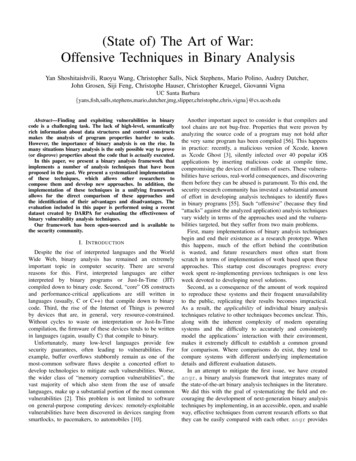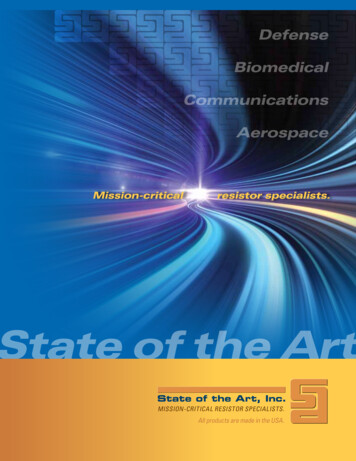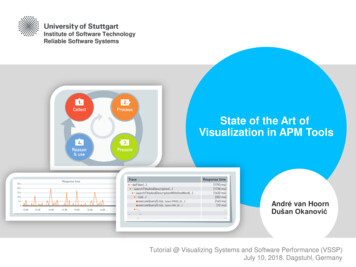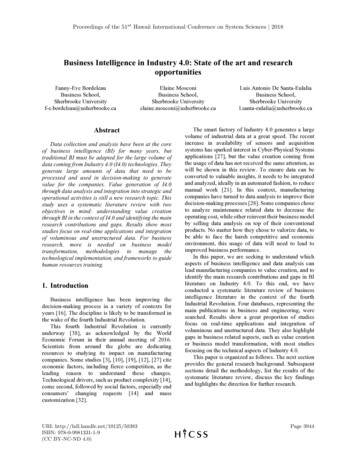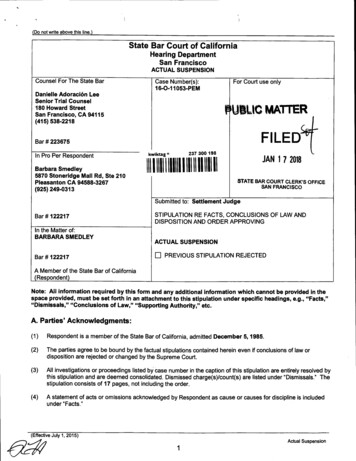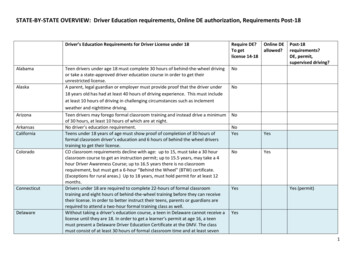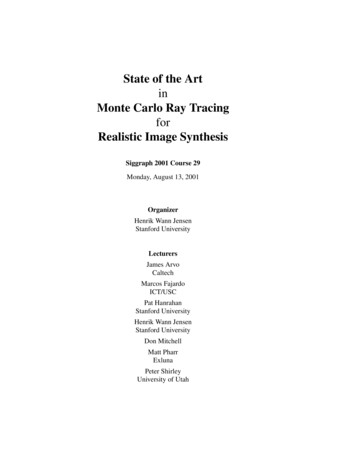
Transcription
State of the ArtinMonte Carlo Ray TracingforRealistic Image SynthesisSiggraph 2001 Course 29Monday, August 13, 2001OrganizerHenrik Wann JensenStanford UniversityLecturersJames ArvoCaltechMarcos FajardoICT/USCPat HanrahanStanford UniversityHenrik Wann JensenStanford UniversityDon MitchellMatt PharrExlunaPeter ShirleyUniversity of Utah
AbstractThis full day course will provide a detailed overview of state of the art in MonteCarlo ray tracing. Recent advances in algorithms and available compute powerhave made Monte Carlo ray tracing based methods widely used for simulatingglobal illumination. This course will review the fundamentals of Monte Carlomethods, and provide a detailed description of the theory behind the latest techniques and algorithms used in realistic image synthesis. This includes path tracing,bidirectional path tracing, Metropolis light transport, scattering equations, irradiance caching and photon mapping.
LecturersJim ArvoComputer Science 256-801200 E. California Blvd.California Institute of TechnologyPasadena, CA91125Phone: 626 395 6780Fax: 626 792 4257arvo@cs.caltech.eduhttp://www.cs.caltech.edu/ arvoJames Arvo has been an Associate Professor of Computer Science at Caltech since1995. From 1990 to 1995 he was a senior researcher in the Program of ComputerGraphics at Cornell University. He received a B.S. in Mathematics from MichiganTechnological University, an M.S. in Mathematics from Michigan State University, and a Ph.D. in Computer Science from Yale University in 1995. His researchinterests include physically-based image synthesis, Monte Carlo methods, humancomputer interaction, and symbolic computation. Dr. Arvo received a young investigator award from the U.S. Army Research Office 1996, an Alfred P. SloanResearch Fellowship in 1997, and a National Science Foundation Career Award in1999 for his work in image synthesis.Marcos FajardoInstitute for Creative TechnologiesUniversity of Southern California13274 Fiji WayMarina del Rey, CA 90292Phone: 310 574 7810, ext 1810Fax: 310 574 5725fajardo@ict.usc.eduMarcos Fajardo is a Research Associate at the University of Southern California’sInstitute for Creative Technologies, working with Dr. Paul Debevec on global illumination and inverse global illumination techniques in large scale environments.He studied Computer Science at the University of Malaga, Spain, and has beenworking on different commercial renderers over the past 5 years, as well as consulting with animation studios on practical global illumination issues. His latestrendering code is codenamed Arnold.
Pat HanrahanGates Computer Science 370BStanford UniversityCA 94305-4070Phone: 650 723 8530Fax: 650 723 stanford.edu/ hanrahanPat Hanrahan is the CANON USA Professor of Computer Science and Electrical Engineering at Stanford University where he teaches computer graphics. Hiscurrent research involves visualization, image synthesis, and graphics systems andarchitectures. Before joining Stanford he was a faculty member at Princeton. Hehas also worked at Pixar where he developed developed volume rendering software and was the chief architect of the RenderMan(TM) Interface - a protocol thatallows modeling programs to describe scenes to high quality rendering programs.Previous to Pixar he directed the 3D computer graphics group in the ComputerGraphics Laboratory at New York Institute of Technology. Professor Hanrahanhas received three university teaching awards. In 1993 he received an AcademyAward for Science and Technology, the Spirit of America Creativity Award, theSIGGRAPH Computer Graphics Achievement Award, and he was recently electedto the National Academy of Engineering.Henrik Wann JensenGates Computer Science 362BStanford UniversityCA 94305-4070Phone: 650 725 3696Fax: 650 723 anford.edu/ henrikHenrik Wann Jensen is a Research Associate at Stanford University where he isworking with professor Pat Hanrahan in the Computer Graphics Group on realisticimage synthesis, global illumination and new appearance models. He is the authorof ”Realistic Image Synthesis using Photon Mapping”, AK Peters 2001. Prior tocoming to Stanford in 1999, he was working in a postdoctoral position at MIT, andas a research scientist in industry where he added photon maps to a commercialrenderer. He received his M.Sc. and Ph.D. in Computer Science from the TechnicalUniversity of Denmark for developing the photon mapping method.
Don Mitchell2621 168th Ave. NEBellevue,WA 98008DonPMitchell@hotmail.comDon Mitchell’s background is in Physics. He worked for Ed Stone at Caltech forseveral years, on heavy-nuclei cosmic radiation, but then dropped out to take a jobworking with computer researchers at Bell Telephone Laboratories in 1981. He didsome research on distributed databases and deadlock detection before becominginterested in 3D image synthesis. Until 1993, he worked at AT&T, mostly on thenumerical and signal processing issues in ray tracing. From 1991 to 1994, hebecame a graduate student at Princeton University, to work with Pat Hanrahan andDavid Dobkin. While at Princeton, he became interested in 3D game technology,MUDs, virtual worlds and the blossoming revolution of personal computers. Andso in 1994, he joined the virtual worlds group at Microsoft Research. In October2000, he retired, and is currently planning a start-up company with a few friends tofurther explore massively multi-user games and virtual worlds. Don Mitchell haspublished several SIGGRAPH papers on efficient sampling techniques.Matt PharrExluna1900 Addison St, Suite 200Berkeley CA 94704mmp@exluna.comMatt Pharr is a co-founder of Exluna, Inc., where he has contributed substantiallyto the design and implementation of the Entropy rendering architecture. He is currently working on interactive rendering technologies. He is expected to completehis Ph.D. in Computer Science at Stanford University in 2001. Matt has publishedthree papers at SIGGRAPH over the past five years on the topics of light scattering, Monte Carlo, and rendering of large scenes. He was a part-time member ofPixar’s Rendering R&D group from 1998-2000, contributing to development ofPhotoRealistic RenderMan and next generation rendering architectures. He has aB.S degree in Computer Science from Yale University and an M.S. from Stanford.
Peter ShirleyComputer Science Department50 Central Campus DriveUniversity of UtahSalt Lake City, UT 84112Phone: 801 585 1883Fax: 801 581 5843shirley@cs.utah.eduhttp://www.cs.utah.edu/ shirleyPeter Shirley is an Associate Professor in the School of Computing at the University of Utah in Salt Lake City. His interests include computer graphics in general,with particular emphasis on rendering. He is the author or co-author of 50 technical articles on topics including rendering, simulation, visualization, and algorithmanalysis. He is the author of ”Realistic Ray Tracing” with AK Peters. Prior to joining University of Utah in 1996, he has worked at the Cornell program of ComputerGraphics and the Indiana University Computer Science Department. He holds aB.A. in Physics from Reed College and a Ph.D. in Computer Science from theUniversity of Illinois at Champaign-Urbana.
Course Syllabus8:30 Introduction and WelcomeHenrik Wann Jensen8:35 Fundamentals of Monte Carlo IntegrationPeter ShirleyAn overview of Monte Carlo integration techniques.Rejection methodsImportance samplingStratified sampling9:15 Quasi-Monte Carlo TechniquesDon MitchellHammersley pointsArbitrary-edge discrepancyApplications of quasirandom techniques to distribution ray tracingSpectral sampling techniques10:00 Break10:15 Sampling TechniquesJames ArvoSampling of special geometries and reflection modelsRussian roulette11:00 Direct IlluminationPeter ShirleySampling of light sourcesSpecial types of light sourcesEfficient sampling of many light sources11:30 Variance Reduction TechniquesJames ArvoCombined estimatorsHybrid sampling methods.
12:00 Lunch1:30 Solving the Rendering EquationPat HanrahanThe path integral formulationPath tracingAdjoint techniquesBidirectional transportBidirectional path tracing2:30 Metropolis SamplingMatt PharrOne dimensional settingMotion blurMetropolis light tansport3:00 Break3:15 Scattering EquationsMatt PharrSampling phase functionsSampling exponential distributionsReflection equationsAdding equations3:45 Monte Carlo Ray Tracing in ActionMarcos FajardoExample images and animations4:05 Biased TechniquesHenrik Wann JensenBiased vs. consistent methodsFiltering TechniquesIrradiance CachingPhoton Mapping5:00 Conclusion and Questions
Contents1Introduction1.1 Purpose of this Course . . . . . . . . . . . . . . . . . . . . . . .1.2 Prerequisites . . . . . . . . . . . . . . . . . . . . . . . . . . . . .1.3 Acknowledgements . . . . . . . . . . . . . . . . . . . . . . . . .131414142Fundamentals of Monte Carlo Integration2.1 Background and Terminology . . . . . . . . . . . . . . . . . . .2.1.1 One-dimensional Continuous Probability Density Functions2.1.2 One-dimensional Expected Value . . . . . . . . . . . . .2.1.3 Multi-dimensional Random Variables . . . . . . . . . . .2.1.4 Variance . . . . . . . . . . . . . . . . . . . . . . . . . . .2.1.5 Estimated Means . . . . . . . . . . . . . . . . . . . . . .2.2 Monte Carlo Integration . . . . . . . . . . . . . . . . . . . . . .2.2.1 Quasi-Monte Carlo Integration . . . . . . . . . . . . . . .2.2.2 Multidimensional Monte Carlo Integration . . . . . . . .2.3 Choosing Random Points . . . . . . . . . . . . . . . . . . . . . .2.3.1 Function inversion . . . . . . . . . . . . . . . . . . . . .2.3.2 Rejection . . . . . . . . . . . . . . . . . . . . . . . . . .2.3.3 Metropolis . . . . . . . . . . . . . . . . . . . . . . . . .2.4 Monte Carlo Simulation . . . . . . . . . . . . . . . . . . . . . .2.5 Density Estimation . . . . . . . . . . . . . . . . . . . . . . . . .151515161718191921222324262729303Direct Lighting via Monte Carlo Integration3.1 Mathematical framework . . . . . . . . .3.2 Sampling a spherical luminaire . . . . . .3.3 Non-diffuse Luminaries . . . . . . . . . .3.4 Direct Lighting from Many Luminaires .31313336379.
3.4.13.4.24567Constant αi . . . . . . . . . . . . . . . . . . . . . . . . .Linear αi . . . . . . . . . . . . . . . . . . . . . . . . . .3839Stratified Sampling of 2-Manifolds4.1 Introduction . . . . . . . . . . . . . . . . . .4.2 A Recipe for Sampling Algorithms . . . . . .4.3 Analytic Area-Preserving Parametrizations .4.3.1 Sampling Planar Triangles . . . . . .4.3.2 Sampling the Unit Disk . . . . . . . .4.3.3 Sampling the Unit Hemisphere . . . .4.3.4 Sampling a Phong Lobe . . . . . . .4.3.5 Sampling Spherical Triangles . . . .4.4 Sampling Projected Spherical Polygons . . .4.4.1 The Cumulative Marginal Distribution4.4.2 The Sampling Algorithm . . . . . . .414143484849505151565859Combining Sampling Strategies5.1 Introduction . . . . . . . . . . .5.2 Using Multiple PDFs . . . . . .5.3 Possible Weighting Functions . .5.4 Obvious is also Nearly Optimal .6565666870.7171788085.9193949596979899101.Monte Carlo Path Tracing6.1 Solving the Rendering Equation . . . . . .6.2 Monte Carlo Path Tracing . . . . . . . . . .6.3 Random Walks and Markov Chains . . . .6.4 Adjoint Equations and Importance SamplingMetropolis Sampling7.1 Overview . . . . . . . . . . . . . . . . . .7.1.1 Detailed Balance . . . . . . . . . .7.1.2 Expected Values . . . . . . . . . .7.2 One Dimensional Setting . . . . . . . . . .7.2.1 Mutations and Transition Functions7.2.2 Start-up bias . . . . . . . . . . . .7.2.3 Initial Results . . . . . . . . . . . .7.2.4 Ergodicity . . . . . . . . . . . . . .
7.37.4897.2.5 Mutations via PDFs . . . . . .Motion Blur . . . . . . . . . . . . . . .7.3.1 Basic Mutation Strategies . . .7.3.2 Re-normalization . . . . . . . .7.3.3 Adapting for large variation in f7.3.4 Color . . . . . . . . . . . . . .Metropolis Light Transport . . . . . . .7.4.1 Path Mutations . . . . . . . . .7.4.2 Pixel Stratification . . . . . . .7.4.3 Direct Lighting . . . . . . . . .7.4.4 Participating Media . . . . . . .Scattering Equations8.1 Interactions . . . . . . . . . . . . . . . . . . .8.1.1 Absorption . . . . . . . . . . . . . . .8.1.2 Scattering at a point . . . . . . . . . .8.2 Non-Linear Reflection Equations . . . . . . . .8.2.1 Sampling from exponential distributions8.2.2 Sampling phase functions . . . . . . .8.2.3 Sampling scattering functions . . . . .8.2.4 Evaluating Reflection Integrals . . . . .8.3 Adding Equations . . . . . . . . . . . . . . . .8.3.1 Monte Carlo Solution . . . . . . . . . .8.4 Results . . . . . . . . . . . . . . . . . . . . . .Biased Techniques9.1 Biased vs. Unbiased . . . . . .9.2 Filtering Techniques . . . . .9.3 Adaptive Sampling . . . . . .9.4 Irradiance Caching . . . . . .9.5 Photon Mapping . . . . . . . .9.5.1 Pass 1: Photon Tracing9.5.2 The Radiance Estimate9.5.3 Pass 2: Rendering . 126126128129130131133.137137139141141144144145147
10 Monte Carlo Ray Tracing in Action15110.1 The ARNOLD Renderer . . . . . . . . . . . . . . . . . . . . . . 15110.2 Example Images . . . . . . . . . . . . . . . . . . . . . . . . . . . 154A Quasi-Random Techniques (slides)163References18512
Chapter 1IntroductionRealistic image synthesis is increasingly important in areas such as entertainment(movies, special effects and games), design, architecture and more. A commontrend in all these areas is to request more realistic images of increasingly complexmodels. Monte Carlo ray tracing based techniques are the only methods that canhandle this complexity. Recent advances in algorithms and compute power hasmade Monte Carlo ray tracing the natural choice for most problems. This is asignificant change from just a few years back when the (finite element) radiositymethod was the prefered algorithm for most graphics researchers.Monte Carlo ray tracing has several advantages over finite element methods. Arecent list from [22] includes: Geometry can be procedural No tessellation is necessary It is not necessary to precompute a representation for the solution Geometry can be duplicated using instancing Any type of BRDF can be handled Specular reflections (on any shape) are easy Memory consumption is low The accuracy is controlled at the pixel/image level13
Complexity has empirically been found to be O(log N ) where N is number of scene elements. Compare this with O(N log N ) for the fastest finiteelement methods [11].In addition one might add that Monte Carlo ray tracing methods can be veryeasy to implement. A basic path tracing algorithm which has all of the aboveadvantages is a relatively straightforward extension to ray tracing.The main problem with Monte Carlo ray tracing is variance seen as noise in therendered images. This noise can be eliminated by using more samples. Unfortunately the convergence of Monte Carlo methods is quite slow, and a large numberof samples can be necessary to reduce the variance to an acceptable level. Anotherway of reducing variance is to try to be more clever; a large part of this course material is devoted to techniques and algorithms for making Monte Carlo ray tracingmore efficient.1.1Purpose of this CourseThe purpose of this course is to impart upon the attendies a thorough understandingof the principles of Monte Carlo ray tracing methods, as well as a detailed overviewof the most recently developed methods.1.2PrerequisitesThe reader is expected to have a good working knowledge of ray tracing and toknow the basics of global illumination. This includes knowledge of radiometricterms (such as radiance and flux) and knowledge of basic reflection models (suchas diffuse, specular and glossy).1.3AcknowledgementsFunding for the authors of these notes include DARPA DABTB63-95-C0085 andan NSF Career Award (CCR9876332).14
Chapter 2Fundamentals of Monte CarloIntegrationThis Chapter discusses Monte Carlo integration, where random numbers are usedto approximate integrals. First some basic concepts from probability are reviewed,and then they are applied to numerically estimate integrals. The problem of estimating the direct lighting at a point with arbitrary lighting and reflection propertiesis then discussed. The next Chapter applies Monte Carlo integration to the directlight problem in ray tracing.2.1Background and TerminologyBefore getting to the specifics of Monte Carlo techniques, we need several definitions, the most important of which are continuous random variable, probabilitydensity function (pdf), expected value, and variance. This section is meant as areview, and those unfamiliar with these terms should consult an elementary probability theory book (particularly the sections on continuous, rather than discrete,random variables).2.1.1One-dimensional Continuous Probability Density FunctionsLoosely speaking, a continuous random variable x is a scalar or vector quantitythat “randomly” takes on some value from the real line R ( , ). Thebehavior of x is entirely described by the distribution of values it takes. This distribution of values can be quantitatively described by the probability density function,15
p, associated with x (the relationship is denoted x p). The probability that x willtake on a value in some interval [a, b] is given by the integral:Probability(x [a, b]) bZp(x)dx.(2.1)aLoosely speaking, the probability density function p describes the relative likelihood of a random variable taking a certain value; if p(x1 ) 6.0 and p(x2 ) 3.0,then a random variable with density p is twice as likely to have a value “near” x1than it it to have a value near x2 . The density p has two characteristics:p(x) 0 (Probability is nonnegative),Z(2.2) p(x)dx 1 (Probability(x R) 1).(2.3) As an example, the canonical random variable ξ takes on values between zero(inclusive) and one (non-inclusive) with uniform probability (here uniform simplymeans each value for ξ is equally likely). This implies that the probability densityfunction q for ξ is: 1 if 0 ξ 1q(ξ) 0 otherwiseThe space over which ξ is defined is simply the interval [0, 1). The probability thatξ takes on a value in a certain interval [a, b] [0, 1) is:Probability(a ξ b) Zb1dx b a.a2.1.2One-dimensional Expected ValueThe average value that a real function f of a one dimensional random variable withunderlying pdf p will take on is called its expected value, E(f (x)) (sometimeswritten Ef (x)):E(f (x)) Zf (x)p(x)dx.The expected value of a one dimensional random variable can be calculated byletting f (x) x. The expected value has a surprising and useful property: the16
expected value of the sum of two random variables is the sum of the expectedvalues of those variables:E(x y) E(x) E(y),for random variables x and y. Because functions of random variables are themselves random variables, this linearity of expectation applies to them as well:E(f (x) g(y)) E(f (x)) E(g(y)).An obvious question is whether this property holds if the random variables beingsummed are correlated (variables that are not correlated are called independent).This linearity
ware and was the chief architect of the RenderMan(TM) Interface - a protocol that allows modeling programs to describe scenes to high quality rendering programs. Previous to Pixar h



